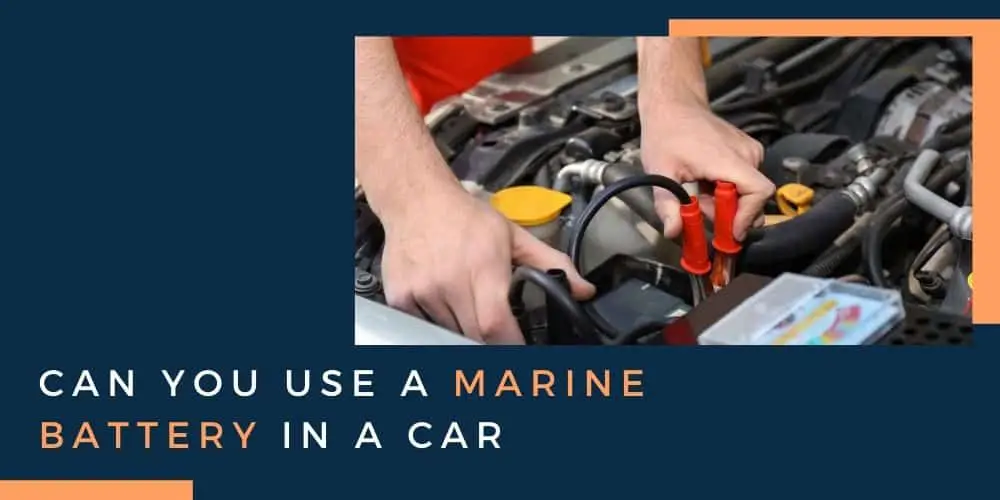Do-It-yourselfers have, arguably, one of the best hobbies in the world. Taking things apart, putting them back together, and making them more efficient teaches you all kinds of things and brings up many interesting questions. You might be wondering, for instance, “can you use a marine battery in a car?”
You can use a marine battery to start a car but you are going to have to approach the problem with a few important factors in mind. Done right, you can indeed start up and run a car on a marine battery. As long as it is a 12-volt marine battery then it will indeed get the car started as we’ve promised.
We’ll go over what you need to consider so that you can approach the problem the way that you need to, by figuring in the space required, the output needed, and maybe a thing or two you hadn’t initially considered.
After all, when you boil it down to the basics, you’ve got a battery and you’ve got a machine that needs electricity, there’s surely a way to make it work!
Read out guide to buying a marine deep cycle battery here!

Consider the function of a car battery
When you consider the function of a car battery then using a marine battery is actually less of a ‘wacky thing to so’ and more of a fun and educational way to demonstrate your knowledge about interfacing machines with an ‘unconventional’ power supply.
Your car battery, in many cases, is essentially there just to get the car started. Once the engine is running you’ve got your alternator to generate power for use and to keep that battery charged and this provides the bulk of your energy.
One important difference between a car and a marine battery is in the thickness of their plates.
Car batteries have thinner plates, which makes it easier for them to release more energy right away for starting that engine. Those thinner plates make them less resilient than marine batteries, however, which have much thicker plates.
Simply put, car batteries are ‘perky sprinters’ while marine batteries are more like ‘distance runners’. Though not recommended as a long-term solution, a marine engine can certainly make a car go.
Breaking the problem down into easily-digestible chunks
First off, you are going to need to consider exactly what you are using the battery for. Yes, it will work with a car, but functionality expectations need to be realistic. That said, as long as it is a 12 volt marine battery then it will indeed get the car started as we’ve promised.
That’s great and a good first hurdle. It will start the car and it will function as a deep cycle battery for our needs. There are, however, some other things to consider:
- What about reserve capacity? – Your alternator generates power for quite a lot of different parts of your car. If it is unable to do so, the ‘Reserve Capacity’ is essentially a time figure of how long your deep cycle battery can keep these things running assuming it starts at 100% charged. This is important, because it won’t be a practical power source if it can’t keep the vehicle powered long enough for its intended purposes.
- Is the size and design compatible? – While you can technically run a car on just about any 12 volt, you’ve still got to fit that battery in the space you’ve got. Does the configuration of the terminals support along with the size provide an easy way to do this? Batteries for cars have a term called ‘Battery Group Size’ that refers to sizes designed for specific makes and models. You’ll need to get creative to fit your marine battery.
- What is the Cold Cranking amperage? – The temperature outside is going to have an effect on how much electricity you are able to efficiently generate and the ‘Cold Cranking amp’ rating refers to this. It’s basically what your battery can produce when it’s 0 degrees outside, more specifically its how many amps a 12 volt battery can produce at 0 degrees, for at least 30 seconds, with a 7.2 volt output minimum per cell!
It can be done, but should it be done?
As you can see, it’s not really so much a question of ‘can you use a marine battery in a car’ as much as it is a puzzle focused on getting the battery to fit and determining the limitations of this model.
A good example of this problem solved quite efficiently is the good old golf cart. These little vehicles are perfect for getting around the course and run on a deep cycle battery.
While you can certainly go beyond that scope with a larger vehicle, we wouldn’t recommend it for anything more than a little entertainment, unless you are testing out a few innovative ideas that you have thought up in your spare time in that workshop of yours.
Running a car on a marine battery simply isn’t very practical or cost effective and ultimately, over time, might reduce the lifespan of both your car’s electrical architecture as well as your marine battery.
That said, for those of you who are already thinking about where that spare marine battery is stored we wish you the best and hope that you have fun with this little exercise.
For some of the answer to ‘should it be done’ is always a resounding ‘yes!’.






